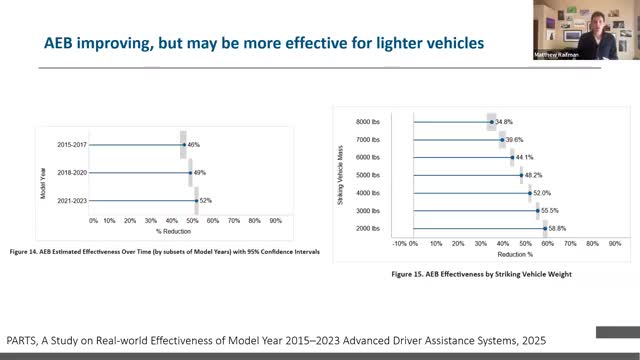California analysis reveals vehicle weight impacts automatic emergency braking efficacy
July 18, 2025 | Transportation Commission, Agencies under Office of the Governor, Executive, California
This article was created by AI summarizing key points discussed. AI makes mistakes, so for full details and context, please refer to the video of the full meeting. Please report any errors so we can fix them. Report an error »

In a recent meeting held by the California Transportation Commission, experts gathered to discuss the findings of a Vehicle Weight Safety Study, shedding light on the evolving landscape of vehicle safety technology and its implications for road safety in the state. The meeting, which took place on July 18, 2025, revealed significant insights into the relationship between vehicle weight and the effectiveness of automatic emergency braking systems.
As vehicles have become newer, the efficacy of automatic emergency braking has improved markedly. Research presented during the meeting indicated that lighter vehicles, weighing around 2,000 pounds, demonstrated nearly double the effectiveness of these systems compared to heavier vehicles, such as those weighing 8,000 pounds. This correlation between vehicle weight and braking effectiveness is crucial, as it highlights the need for further study into how vehicle design impacts safety features.
The meeting also provided a comprehensive overview of California's registered vehicle fleet, which currently stands at approximately 30 million vehicles. Notably, 89% of these are personal vehicles, with SUVs rapidly gaining popularity. Data showed that while sedans remain the most registered vehicle type, the proportion of SUVs has surged by 70% from 2010 to 2023, suggesting they may soon surpass sedans in registration numbers.
In terms of vehicle dimensions, the average weight of registered vehicles has increased over the past decade, with pickup trucks experiencing the most significant growth at 7%. This trend raises important questions about the implications of heavier vehicles on road safety, particularly in light of the findings regarding automatic emergency braking.
The meeting also touched on the rise of electric vehicles (EVs) in California. While the percentage of gasoline and diesel vehicles has decreased from 98% in 2010 to 87.5% in 2024, the weight of electric vehicles poses additional challenges. For instance, the electric versions of popular models like the Ford F-150 and Toyota RAV4 are significantly heavier than their gasoline counterparts, which could affect their braking performance.
As the discussion concluded, the need for policies that consider the geographical distribution of vehicle types and weights was emphasized. With urban and rural areas exhibiting different vehicle registration trends, any regulatory measures must account for these disparities to ensure equitable safety standards across the state.
The insights from this meeting not only highlight the advancements in vehicle safety technology but also underscore the critical need for ongoing research and policy development to address the challenges posed by heavier vehicles and the growing prevalence of electric vehicles on California's roads.
As vehicles have become newer, the efficacy of automatic emergency braking has improved markedly. Research presented during the meeting indicated that lighter vehicles, weighing around 2,000 pounds, demonstrated nearly double the effectiveness of these systems compared to heavier vehicles, such as those weighing 8,000 pounds. This correlation between vehicle weight and braking effectiveness is crucial, as it highlights the need for further study into how vehicle design impacts safety features.
The meeting also provided a comprehensive overview of California's registered vehicle fleet, which currently stands at approximately 30 million vehicles. Notably, 89% of these are personal vehicles, with SUVs rapidly gaining popularity. Data showed that while sedans remain the most registered vehicle type, the proportion of SUVs has surged by 70% from 2010 to 2023, suggesting they may soon surpass sedans in registration numbers.
In terms of vehicle dimensions, the average weight of registered vehicles has increased over the past decade, with pickup trucks experiencing the most significant growth at 7%. This trend raises important questions about the implications of heavier vehicles on road safety, particularly in light of the findings regarding automatic emergency braking.
The meeting also touched on the rise of electric vehicles (EVs) in California. While the percentage of gasoline and diesel vehicles has decreased from 98% in 2010 to 87.5% in 2024, the weight of electric vehicles poses additional challenges. For instance, the electric versions of popular models like the Ford F-150 and Toyota RAV4 are significantly heavier than their gasoline counterparts, which could affect their braking performance.
As the discussion concluded, the need for policies that consider the geographical distribution of vehicle types and weights was emphasized. With urban and rural areas exhibiting different vehicle registration trends, any regulatory measures must account for these disparities to ensure equitable safety standards across the state.
The insights from this meeting not only highlight the advancements in vehicle safety technology but also underscore the critical need for ongoing research and policy development to address the challenges posed by heavier vehicles and the growing prevalence of electric vehicles on California's roads.
View full meeting
This article is based on a recent meeting—watch the full video and explore the complete transcript for deeper insights into the discussion.
View full meeting
